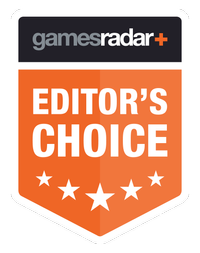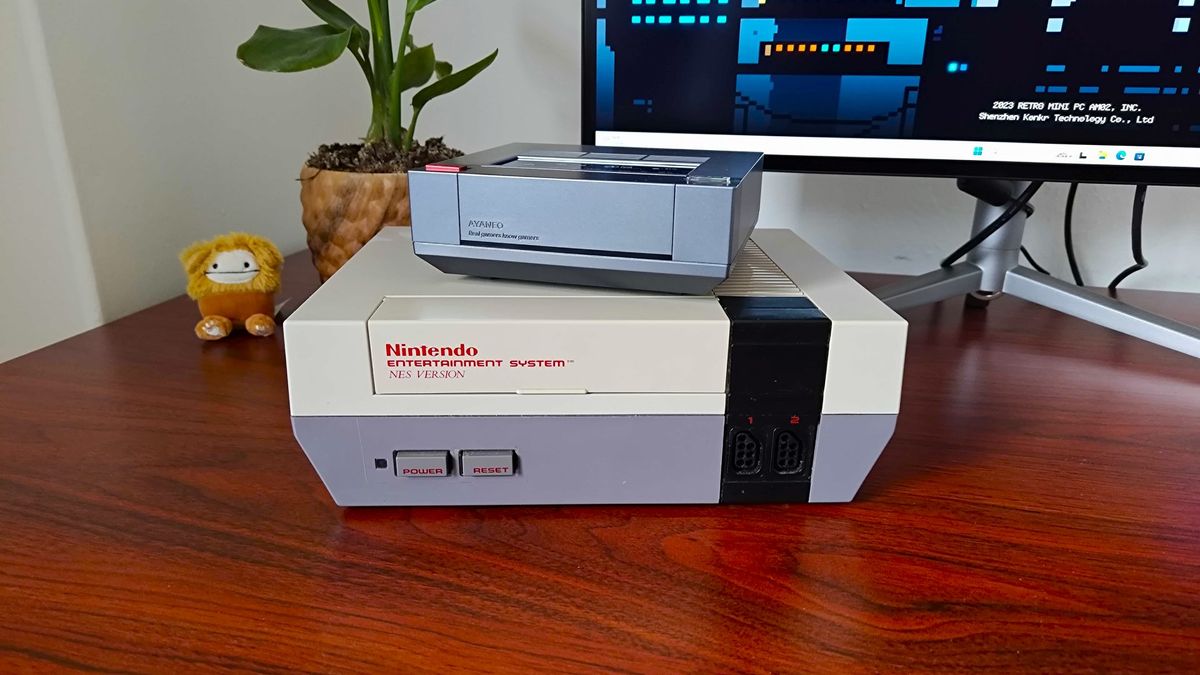12DOVE Verdict
The Ayaneo Mini PC AM02 proves that tiny rigs can boast both beauty and power, and it’s much more than a nostalgic nod. While its contemporary Nintendo Entertainment System vibes provide this tiny rig with an exceptional aesthetic, the compact machine’s specs and capabilities also make it a must-have for both retro fans and PC players looking for a living room rig.
Pros
- +
Great price
- +
Stylish NES-style design
- +
Fantastic compact performance
- +
4-inch screen built-in
Cons
- -
Some screen features yet to roll out
Why you can trust 12DOVE
Even before getting my hands on the Ayaneo Mini PC AM02, I knew I’d be on board with its mission. I mean, the fact it looks like an NES is enough to warrant excitement, but as someone who plays around with handhelds, the idea of using the tech to create a tiny build just made a lot of sense. Now that I’ve spent a chunk of time with the machine, I can confirm that I’ve fallen head-over-heels for the tiny gaming PC, and I’ve never been this hyped for a low-spec rig.
Okay, let me back up a little, as I don’t want my excitement for the AM02 to get in the way of proper insights. As much as I loved the concept of Ayaneo’s dinky device, I wasn’t wholly convinced it’d rank among the best gaming PCs out there. Initially, I was worried that its size would mean it’d be consigned to merely running classic capers, with limitations on par with the lower-spec AM01 model.
Yet, taking this new mini PC for a test run quickly revealed that it is capable of handling new games in a similar way to the best gaming handhelds, and that’s an incredible feat. Keep in mind we’re talking about a rig that starts at $499 / £399 and occupies the same footprint as a PS2 case. Provided you’re not looking for something you can take on the go, this could be the perfect format for minimalist gamers or players looking for a compact living room solution, and I hope rivals are taking notes in terms of design.
The Ayaneo Mini PC AM02 is currently available via an ongoing Indiegogo campaign, so swing by the page for early bird offers and more. We'll keep you posted once the device arrives at other storefronts.
Specs
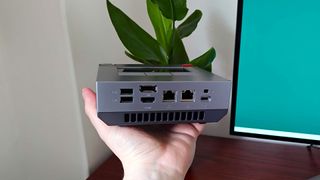
Before diving into the AM02’s devilish good looks and abilities, let’s run over some specs. At its core, the mini PC uses an AMD Ryzen 7840HS APU with a 45W TDP – slightly beefier than the chip used within the Ayaneo 2S. The model I’ve been testing is also rocking 32GB DDR5 RAM and a 1TB SSD, which is bananas considering many full-sized rigs out there still use 16GB. You could say pairing these sorts of components with a CPU like this is overkill, but the extra headroom is more beneficial than you’d think.
| Price | $499 - $769 (£400 - £616 est) |
| APU | AMD Ryzen 7840HS |
| RAM | Up to 32GB DDR5 |
| Storage | Up to 2TB SSD |
| Audio | 3.5mm headphone jack |
| Operating system | Windows 11 Home |
Round the back, you’ll find a surprising number of ports, including HDMI 2.0, DisplayPort 1.4, two full-sized USB ports, and a double helping of Ethernet. The latter will help you use the AM02 as a NAS if you so desire, which is an ideal use case for the machine considering its capacity, size, and incredibly low 70W power consumption.
What’s that? You’re wondering why it only has two USB ports? Well, don’t worry, as there are another three hidden under the PC’s front flap, one of which is a USB-C connector. You’ll also find a headphone jack stowed away up front too, just in case you prefer to use a gaming headset with a 3.5mm cable.
Design


Yes, the fact that the Mini PC AM02 looks like a tiny NES is its main design pitch, but there’s honestly more to this piece of hardware than old Nintendo vibes. For starters, it feels like Ayaneo is going for an element of retro-futurism, with Ninty’s classic style elements being paired with a silver and grey metallic paint job that adds contemporary spice. Of course, the fact it’s also armed with a small four-inch LCD screen on top drives home this theme, resulting in something you’d expect to see in the background of a sci-fi anime.
On top of that, Ayaneo adds an element of physical interaction that also maintains a practical use case. As I mentioned before, the PC’s front IO is hiding under a flap, and the lip replicates the feel of an NES cartridge slot. However, the handheld makers have slyly added an ‘open’ button that evokes vibes of different consoles like the SNES, even though the functionality isn’t quite the same as any real retro console out there. Just in case it wasn’t clear, I absolutely love this, as it draws on nostalgic vibes without merely mimicking past innovations.
Another subtle styling I greatly appreciate is the transparent jewel-style power button, which again, feels vintage without actually copying anything specific. The same goes for its vent placement, as its top grill sparks something in my brain that harks back to wondering what the ridges on the Sega Mega Drive were actually for during my youth.
That aside, I want to wrap up my thoughts on design by commending the dimensions of this device. It’s effectively the same size as a GameCube if you chop two-thirds off the top, and while I don’t doubt there are similar builds out there, the AM02 still feels beautifully compact.
Features



Many of the Mini PC AM02’s features are things you’ll also find in Ayaneo’s handheld selection. Before I dive into that side of things, let’s chat about that unique four-inch touchscreen living on the top of Ayaneo’s machine. Designed to be a utility hub, you’ll be able to swipe between different views, including real-time performance data, a stylish 24-hour clock, and even screensavers with a future update.
The former is the screen perhaps more useful, especially if you like to clock-watch fps and temperature figures. With just a tap, you’ll be able to change power settings without any software intervention, and you’ll always be able to tell whether you’re working the little guy too hard at a glance. That said, there’s a lot to love about the screen’s aesthetic functionality too, as it’ll help add a bit of flair to your gaming desk that isn’t just the usual helping on RGB lighting. Sadly, the screensaver option hasn’t arrived yet, but it should roll out at some point via a firmware patch.
Moving onto some software chat, and we’re talking about a similar Windows 11 experience to the company's handhelds. Just like with the AM01, the Mini PC AM02 uses Ayaneo’s management hub, Ayaspace, to provide access to performance settings and serve as an all-around gaming hub. The software will enable you to tweak things like TDP and fan speeds to your liking, and it’s amazing how far the app has come since I first took the Ayaneo 2S for a spin. The interface is clean and easy to navigate, and there’s even a widget on the desktop for quick access to frequently used dials.
Performance
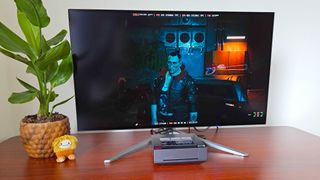
Alright, time to throw the AM02 Mini PC in the benchmark ring, and I’ll be treating the rig like a handheld for this review. That means I’ll be keeping settings low while running 1080p scenarios, as that way we’ll have results we can compare to the Steam Deck OLED and other small machines.
| Game tested | Average fps (1080p, low settings) |
|---|---|
| Cyberpunk 2077 | 46fps |
| Hitman 3 | 76fps |
| Total War: Warhammer 3 | 42fps |
| Shadow of the Tomb Raider | 54fps |
I always like to kick off with Cyberpunk 2077, and I honestly wasn’t expecting anything spectacular from the AM02 as it dealt with the denseness of Night City. However, I’m delighted to say that the demanding RPG holds up great on this ridiculously small rig, with average frame rates measuring in at around 46fps. That’s without FSR upscaling enabled, but switching AMD’s scaler on ramps that figure up to near 60. I’m pretty confident that the experience at hand is better than what the PS4 could manage when the game first launched, so I’m marking that as a massive win for the Ayaneo system.
Hitman 3 is normally a little bit more forgiving, but I still value the stealth game as a stress test. Reaching around 76fps at 1080p seemed to be a breeze for the AM02 while handling Dartmoor, and low settings actually looked pretty nice considering. Total War: Warhammer does punish the tiny rig a little, with the RTS romp managing around 42fps. I personally don’t think that figure is too bad, but perhaps demanding strategy games aren’t an ideal genre for this setup.
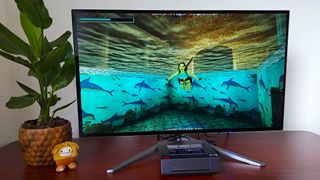
I rounded off my testing with Shadow of the Tomb Raider and a 54fps average. Taking advantage of AMD FSR would ultimately help drive performance up to that 60fps sweet spot, but I can’t remotely grumble at that figure. The fact a big adventure like this can run on a 0.9L system kitted out with a Ryzen APU is fantastic and serves as a testament to the validity of low-spec gaming.
Benchmark tests aside, I’ve been using the AM02 to play a few new games that work wonderfully on the mini PC. If you’ve read my previous AM01 review, you’ll know that I spent a chunk of time playing the OG Tomb Raider ports, but have since switched to playing the Remastered Trilogy. The game doesn’t feature any settings and defaults to whatever screen resolution you happen to be using, and I can confirm that the game will happily run at 4K 60fps on a gaming TV.
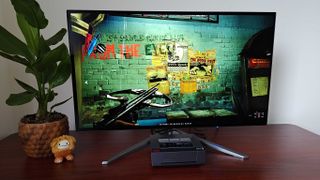
While the new glow-up is still fairly lightweight, I was pretty astounded by this result, and I can see myself playing games of this caliber on the AM02 for the rest of the year. I also made some time to revisit one of my favorite Xbox 360-era games, Dishonored, with the result being an experience that trumps Microsoft’s seventh-gen console. I’d still recommend sticking to sub-UHD resolutions when it comes to new releases, but I’d be lying if I said I wasn’t going to play Fallout: New Vegas on this thing at 4K (that’s seemingly possible, and you may hear more from me on that soon).
Naturally, I also dabbled with some emulation too, firing up a few favorites like PCSX2 and Dolphin to see what’s what. As I suspected, everything runs pretty exceptionally on the AM02, with even demanding classics running at full speed and high resolutions. With a chip like the Ryzen 7840HS, you’ll be able to emulate even newer systems provided you have a legal means to do so, and the end result is quite impressive, to say the least.
Running through some additional performance thoughts, and it only feels right to complement the AM02’s cooling system. Ayaneo has managed to put together a mini PC that rarely feels intrusive when it comes to fan noise, and temperatures only just touch 80°c at 45W under load. With the fans running at 3300rpm, things do become audible, but if you use it with a TV, the sound of your speakers will do a lot of masking.
Should you buy the Ayaneo Mini PC AM02?
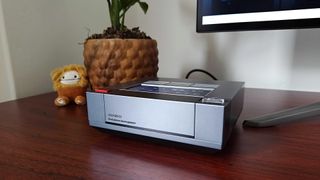
If you’re looking for an incredible small PC for your living space, dorm room, or anywhere that’s got limited space, the Ayaneo Mini PC AM02 is well worth considering. Both its beautiful retro aesthetic and the fact it can handle modern releases make it far more than a novelty, and I’m hoping that machines like this spark a new wave of tiny systems focusing on a small-scale gaming experience.
I could counter-argue with myself and say that you can make your own mini PC using a handheld and one of the best Steam Deck docks. However, the base AM02 costs much less than similar portable PCs, and the Steam Deck OLED has much lower specs. Therefore, I’m confident that Ayaneo’s NES homage has a valid space in the scene today, and honestly? It makes me want to live in a van and use it to play games on a little 1080p display. If you don’t see any reviews after this one, you’ll probably find me in the Scottish highlands replaying Fable or something.
How I tested the Ayaneo Mini PC AM02
For several weeks, I used the Ayaneo Mini PC AM02 to play a selection of games at both my desk and in my living room. During that time, I used the likes of Cyberpunk 2077, Hitman 3, Total War: Warhammer 3, and Shadow of the Tomb Raider to record benchmarks. I also used the system to casually play Dishonored and Tomb Raider Remastered Trilogy, keeping an eye on performance and assessing the PC’s capabilities.
If you’d like to learn more about how we test gaming PCs and other related gizmos, swing by our 12DOVE Hardware Policy for more information.
Looking for more systems? Swing by the best Alienware gaming PC builds for something out of this world. We've also got you covered with the best gaming monitors and best gaming TVs, just in case you're due a screen upgrade.

I’ve been messing around with PCs, video game consoles, and tech since before I could speak. Don’t get me wrong, I kickstarted my relationship with technology by jamming a Hot Wheels double-decker bus into my parent’s VCR, but we all have to start somewhere. I even somehow managed to become a walking, talking buyer’s guide at my teenage supermarket job, which helped me accept my career fate. So, rather than try to realise my musician dreams, or see out my University degree, I started running my own retro pop culture site and writing about video games and tech for the likes of TechRadar, The Daily Star, and the BBC before eventually ending up with a job covering graphics card shenanigans at PCGamesN. Now, I’m your friendly neighbourhood Hardware Editor at GamesRadar, and it’s my job to make sure you can kick butt in all your favourite games using the best gaming hardware, whether you’re a sucker for handhelds like the Steam Deck and Nintendo Switch or a hardcore gaming PC enthusiast.

Ahead of GTA 6, Take-Two CEO says he’s “not worried about AI creating hits” because it’s built on recycled data: “Big hits […] need to be created out of thin air”
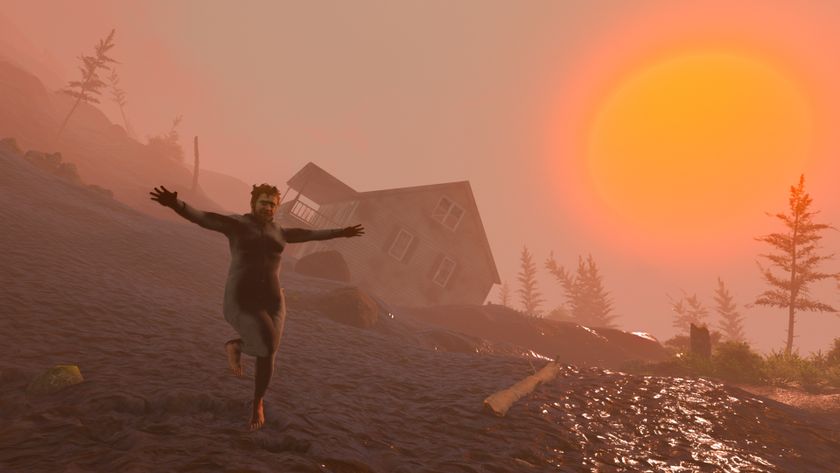
Getting Over It creator Bennett Foddy threatens the world once again: If you want Baby Steps to be a brutal rage game, "you can inflict that on yourself"

A Simpsons Hit and Run Remake will probably never happen – and I don't want it to
